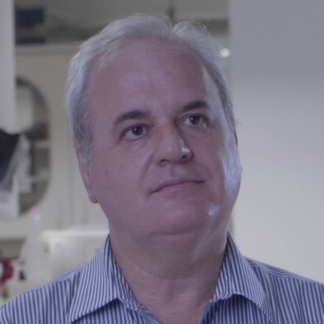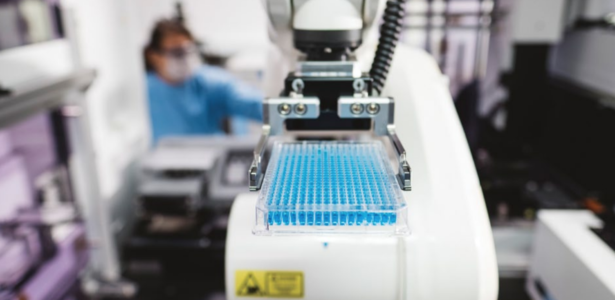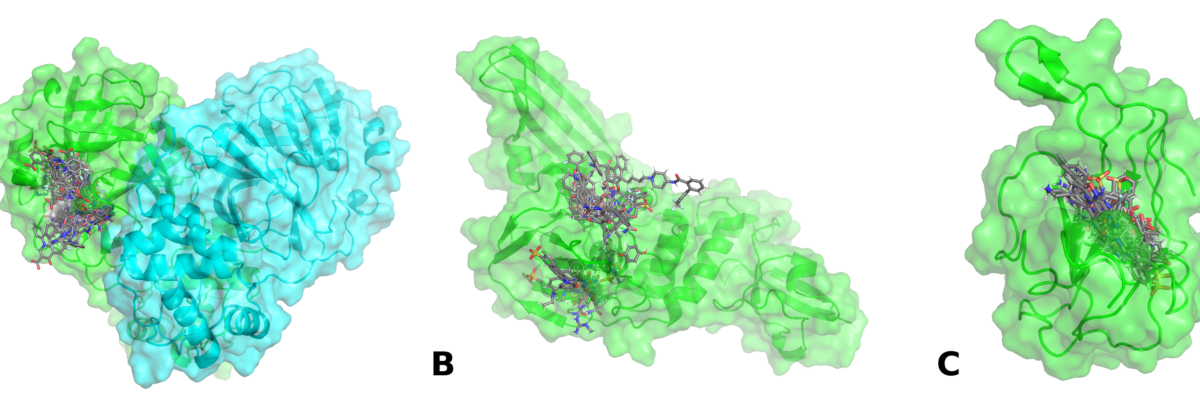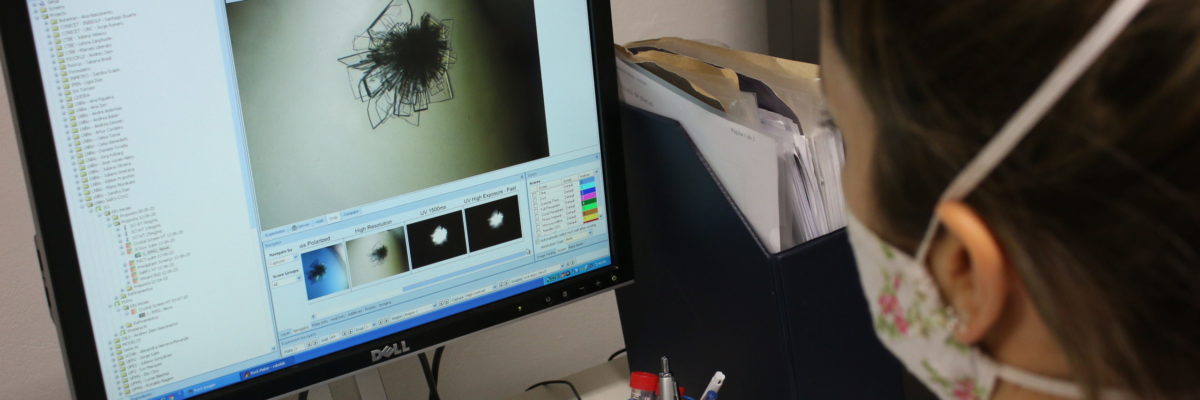When faced with a reality that seemed straight out of science fiction, CNPEM acted quickly and redirected its research and development activities to mobilize its highly qualified human resources framework, its state-of-the-art scientific infrastructure, techniques, and competencies into a task force to fight Covid-19. In addition to the activities carried out as part of Rede Vírus (the Virus Network) coordinated by the COVID-19 Ministry of Science, Technology, and Innovation, in which it worked to repurpose drugs and design and produce face shields, the Center also acted on other fronts:
Covid-19
2020–2021: THE YEARS THAT CHANGED OUR LIVES
1. Generating defective viruses (VLPs) to make it easier to maintain and experiment with the SARS-CoV-2 virus.
2. Developing tests and diagnostics with technology transfer to a hospital and social organization which are partners with CNPEM.
3. Producing recombinant viral proteins, genetic sequencing, and genetic engineering applied to the virus.
4. Developing methods to disinfect environments and surfaces.
CNPEM also supported research related to Covid-19 by external users, opening the doors of its facilities. The accepted proposals mainly utilized electron microscopy, cryomicroscopy, micromanufacturing, and macromolecular crystallization techniques.
JOINT EFFORTS
SEARCHING FOR ANSWERS
By Kleber Franchini,
Director of the Brazilian Biosciences National Laboratory
The COVID-19 pandemic tested CNPEM’s scientific capacity unexpectedly. In a collective effort, we carry out highly complex projects with the potential to impact the understanding of the biology of SARS-CoV-2, the development of research inputs, and the establishment of therapeutic and diagnostic alternatives for COVID-19. To achieve these goals, competencies in computational biology, structural and molecular biology, drug discovery, and disease biology were pooled, supported by the world-class scientific infrastructure available at CNPEM. The effort also included the anticipation of the commissioning and availability for emergency use by the scientific community of Sirius beamline MANACÁ, dedicated to protein crystallography – a fundamental technique for understanding the biology of the virus and for the discovery and development of drugs. As result, we proposed the antiviral drug nitazoxanide for clinical studies of safety and efficacy; we also established serological and saliva tests for detecting viral antigens used by healthcare professionals in a hospital environment; standardized experimental tests; produced reagents and supplies for research; contributed to the development of test vaccines, and deepened the knowledge of the biology of SARS-CoV-2. This scenario brought to light the strategic role of CNPEM in meeting the demands of society. There is an understanding that this will not be the last time a pathogen will threaten our lives and livelihoods. Establishing the means and instruments that can mitigate its impacts requires scientific effort, the establishment of skills, and investments. Our actions in the fight against COVID-19 inspire us to empower ourselves to overcome new challenges in health research and development. With support from the Ministry of Science, Technology and Innovation, CNPEM will host a complex scientific infrastructure dedicated to the biocontainment and research of pathogenic agents, including those that require maximum biological containment. In an unprecedented way, this infrastructure will couple to Sirius, which will allow unique experimental approaches to understand the biology of hazardous pathogens and establish the conditions for the development of rapid and efficient means of coping.

CNPEM IS PART OF THE MCTI'S REDEVÍRUS
The Ministry of Science, Technology, and Innovation (MCTI) mobilized research units, laboratories, and science and technology institutes across Brazil to create Rede Vírus (the Virus Network) to fight the coronavirus. Rede Vírus is a commission that brings together experts, government representatives, scientific incentive agencies from MCTI, research centers, and universities to be part of initiatives to combat emerging viruses. These institutions work together to develop diagnostics, treatments, and vaccines and study the virus.
Electron microscopy images of lymphocytes infected with SARS-Cov-2 virus, where the virus is identified inside the cells, in vesicles. Experiment carried out by researchers from CNPEM and Unicamp.
DEFECTIVE VIRUS PARTICLES (VLPS)
Laboratory studies on agents that may inhibit the novel coronavirus may be facilitated by the use of defective viral particles that do not pose infection risk. Virus-like particles (VLPs) comprising the viral envelope but lacking genetic material were produced; they were investigated using electron microscopy to determine the particle morphology, very similar to assays on wild viral particles. The particle production system is being improved to boost concentration and to permit structural biology testing.
DRUG REPURPOSING AND THE STRUCTURAL BIOLOGY OF THE SARS-COV-2 VIRUS
CNPEM joined the MCTI’s Rede Vírus with a project to identify available medications that could potentially be utilized in treating Covid-19. This activity directly involved the Drug Discovery and Development, Scientific Computing, and Structural Biology Platforms, as well as the Infectious Disease research program established in previous years at CNPEM. Together, this infrastructure and these teams ran tests to screen compounds in silico and in vitro, determined the structure of relevant proteins for the SARS-Cov-2 replication, which can act as targets for antiviral drugs, and made advances in the molecular mechanisms that are important for the SARS-CoV-2 replication cycle, as well as in the action mechanisms for the drugs with potential for use.

Drug repositioning consists of researching drugs already on the market ( which have already been approved by the competent units), for use in new therapies. The High Content Throughput Screening platform is ideal for the trial of efficient drugs
DATA MINING AND SCREENING TO SELECT ACTIVE INGREDIENTS
About two thousand drugs already approved for use to treat other diseases were tested via virtual screening against the two SARS-CoV-2 proteases and the nucleocapsid protein (membrane that contains the virus nucleus) of SARSCoV- 2. This initiative began with molecules which are known to be safe for use in humans available in databases, and used computational approaches to generate a ranking of drugs with the potential to bind to the active site of the target proteins, thus making them candidates for repurposing against Covid-19. Twenty-nine molecules were purified from medicines or purchased. The most notable candidate for repurposing against Covid-19 was nitazoxanide.

Examples of potential receptor-inhibitor complexes identified in virtual screenings against three molecular targets in SARS-CoV-2. (A) 3C-like protease, (B) Papain-like protease, (C) N-terminal domain of the nucleocapsid protein
CORPORATE
PARTNERSHIPS
Alongside the work to repurpose drugs, a partnership was established with the KUNUMI company, which develops models using artificial intelligence. This partnership involves building a database of drugs which are already approved, that will contain data on molecular applications and mechanisms of action, chemical structure, and results from the literature on Covid-19 (such as symptoms, mechanisms, and clinical studies, for example). The company developed a computational model that resulted in a ranking of a hundred potential compounds, thirty of which have not yet been reported in the literature. Of this subset, six showed greater potential and were selected for acquisition and testing by CNPEM.
PARTNERSHIP WITH THE MEDICINE
FOR MALARIA VENTURE (MMV)
CNPEM’s compound screening approach has also resulted in closer partnerships with the Medicine for Malaria Venture (MMV), an international consortium to develop new drugs for infectious diseases including emerging viruses as well as malaria. Screening the available MMV libraries yielded agents that act against SARS-CoV-2; further assessment of the action of these compounds in various types of human cells is currently in the conclusion phase.
DEVICES
CNPEM also worked on developing a platform for ultra-compact devices to diagnose Covid-19 in its early stages. A CNPq-MCTI project to manufacture devices with standard photolithography processes that permit reproducibility and higher quality of these components. The device consists of a sensor made of a thin layer of gold that can detect a disease using a minimal amount of sampling. The general architecture of the device in the form of a microtube makes it possible to concentrate the sample within it, requiring volumes of less than one drop. The setup permits a fast and amplified response via a measurable electrical signal, which can be observed by a computer or even a portable device. In addition to Covid-19, this platform can be used to diagnose other diseases: all that is required is to make the electrodes functional through new layers of bio-recognition.

On the screen, a crystal of the SARS-CoV-2 virus protein, created in the CNPEM Protein Crystallization facility
ASSESSMENT OF FAR-UVC SPECTRUM LIGHT TO ELIMINATE THE SARS-COV-2 VIRUS
CNPEM started a project in partnership with the Vale Technological Institute, co-financed by Vale and by EMBRAPII, in order to assess far-UVC light against the SARS-CoV-2 virus to disinfect surfaces and objects. UV lights emitted by germicidal lamps typically have peak emissions of around 254 nm wavelengths, which can be unsafe for human health. This project explores the window of UV spectrum wavelengths that has antimicrobial action but does not cause damage; preliminary tests involving SARS-CoV-2 yielded promising results. After validation of the strategy adopted in the study, it will be possible to use this type of light at the appropriate wavelength to decontaminate environments without risk to human health, making it a safe and easy-to-use option for various sectors of society.
DEVELOPMENT OF DIAGNOSTIC METHODS
AND DEVICES
CNPEM also worked to develop an immunoenzymatic assay to detect antiviral antibodies to SARSCoV- 2. This assay used a virus clone protein produced at the Center as an antigen for a diagnostic test known as ELISA (enzyme-linked immunosorbent assay) that can detect the presence of antiviral antibodies in human serum in a semi-quantitative manner. Through a partnership with the Dante Pazzanese Hospital, a research protocol was established to access serum samples and PCR data that made it possible to validate this new assay. Furthermore, the technology from the trial was transferred to the hospital, which has already performed more than two housand tests on its staff, and to Biotec Amazônia. A manuscript describing the method was published in the journal Frontiers in Immunology in August 2021. The Elisa test was used for a study with CNPEM staff to link antibody signals and effectiveness of seroneutralization to better understand correlations between the serological test and protective immunity against the virus.
SIRIUS IN THE FIGHT AGAINST COVID-19
With the beginning of restrictive measures, in March 2020, to limit the spread of the coronavirus, activities at Sirius were strategically redirected in order to allow participation in CNPEM’s efforts to face the pandemic. This required readapting the dynamics of the beamline assembly, as well as the activities related to accelerator commissioning in order to protect CNPEM staff. Work to assemble and commission the lines was redirected, focusing on concluding the Manacá (dedicated to the crystallography of macromolecules like proteins) and Cateretê (dedicated to coherent X-ray scattering) beamlines. Both permit important techniques to support the scientific community in its efforts to combat Covid-19. The decision to prioritize these activities considered the nature of the Manacá beamline, which makes it possible to visualize details of biological molecules (such as those that make up viruses) on an atomic scale.
